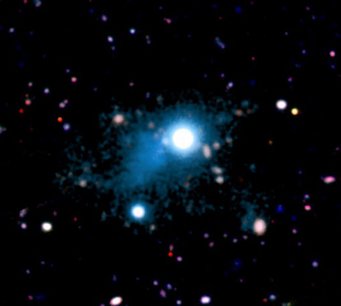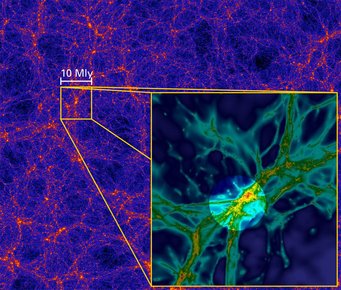Black Hole Powers 'Cosmic Flashlight' Illuminating the Cosmic Web
Cosmologists believe that matter in intergalactic space is distributed in a vast network of interconnected filamentary structures known as the cosmic web. The vast majority of atoms in the Universe reside in this web as primordial hydrogen, vestigial matter left over from the Big Bang. Researchers from the University of California at Santa Cruz and the Max Planck Institute for Astronomy have captured an image of the cosmic web for the first time: they exploited the intense radiation generated by a supermassive black hole, which, like a flashlight, illuminates the cosmic web, revealing its structure.
| Questions and Answers | High-resolution Images |

Supercomputer simulations predict that matter in the Universe is distributed in a network of filaments known as the 'cosmic web', where the vast majority of atoms reside as diffuse hydrogen gas. In this picture, galaxies like our own Milky Way formed at the nodes of this network, where cool dense gas, the fuel for star formation, funnels in along the intersecting filaments. But direct tests of this model were previously lacking, because even at the densest nodes, cosmic web gas is so rarefied that it emits very little light, making it impossible to image even with the world's largest telescopes.
Now astronomers have obtained the first direct images of a portion of the cosmic web, by exploiting the fact that a luminous object known as a quasar can act like a natural 'cosmic flashlight'. Quasars constitute a brief phase in the galactic life-cycle. Powered by the infall of matter onto a galaxy's central supermassive black hole, they shine as the most luminous objects in the Universe. Because the galaxies hosting quasars should also reside at dense nodes of the web, the quasar can illuminate nearby cosmic web gas, revealing its structure. Under the quasar-flashlight's intense glare, the gas emits light via the same mechanism at work in an ordinary fluorescent lamp, namely because it is being constantly bombarded with energy. In the case of ordinary lamps this energy is provided by an electrical current, whereas the cosmic web fluorescence is powered by energy from the quasar radiation.
Sebastiano Cantalupo, a post-doctoral researcher at the University of California at Santa Cruz and the lead author of the study, says: "The light from the quasar is like a flashlight beam, and in this case, we were lucky that the flashlight is pointing right at the cosmic web, making some of its gas glow." Using the 10-meter Keck I Telescope at the W. M. Keck Observatory in Hawaii, the researchers were able to capture an image of the fluorescently glowing cosmic web with the help of a custom-made filter. Fluorescent light reaching us from the targeted portion of the cosmic web has a specific, characteristic color – and only this color is transmitted by the filter.
The hydrogen gas in intergalactic space has been indirectly studied for decades using a different and much more restricted technique that probes the cosmic web along a single line only – the line joining a distant background quasar with an observer here on Earth. (cf. MPIA Science Release 2013_08). But this method could never reveal the spatial structure of the cosmic web.

Fabrizio Arrigoni Battaia, who participated in the observations as part of the work for his doctoral degree at the Max Planck Institute for Astronomy, says: "This is the first time anyone has been able to capture an image of the cosmic web, demonstrating its filamentary structure." The region of the cosmic web visible on the image measures roughly 2 million light-years across.
Such observations can be used to test supercomputer models that simulate the formation of cosmic structures from the Big Bang to the present. Indeed, the new discovery provides evidence that key elements might be missing from current simulations: The amount of cool gas inferred from the image of the cosmic web appears to be substantially larger than predicted.
Joseph Hennawi, a group leader at the Max Planck Institute for Astronomy involved in the study, concludes: "If you want to know how galaxies form, you first need to understand their fuel supply, which comes from the cosmic web. These new observations are challenging our understanding, as they suggest a large amount of gas is contained in small dense clumps, which is not currently present in our models. Resolving this tension will clearly teach us something very important."
Background information
The results described here will be published as a Nature Advanced Online Publication S. Cantalupo et al., "Cosmic Web filament revealed in Lyman α emission around a luminous high-redshift Quasar" on January 19, 2014.
The co-authors are Sebastiano Cantalupo (University of California, Santa Cruz [UCSC], and Lick Observatory), Fabrizio Arrigoni-Battaia (Max Planck Institute for Astronomy [MPIA]), J. Xavier Prochaska (UCSC, Lick Observatory, MPIA), Joseph F. Hennawi (MPIA), and Piero Madau (UCSC).
The observations were made as part of the survey FLASHLIGHT being conducted at the Keck and Gemini South telescopes. FLASHLIGHT stands for "Fluorescent Lyman-Alpha Survey of cosmic Hydrogen iLluminated by hIGH-redshifT quasars. The survey aims to use fluorescent Lyman alpha emission to detect cosmic web gas around distant galaxies, and also study proto-galaxies that have not yet formed substantial numbers of stars (known as "dark galaxies").
Questions and Answers
What is new/important about these results?
This is the first time astronomers have been able to obtain an image of gas in the cosmic web. Previously this gas was studied in absorption against background sources. These relied on chance alignments in which a distant quasar's light would pass part of the cosmic web on its way to Earth. Absorption of some of the quasar's light by the cosmic web gas would yield information about some of the gas's properties. But such chance alignments are rare, and the information obtained only applies to the gas directly along the line of sight – an inherently one-dimensional method that cannot reveal the three-dimensional morphology of the cosmic web.
An image allows astronomers to study the structure of the cosmic web, including information about its size, morphology, clumpiness, as well as the total amount of gas. This is key information for testing models of structure formation in the Universe. Because galaxies accrete cool gas from the cosmic web, which provides the raw-material for star-formation, the structure of this intergalactic gas is intimately related to galaxy formation.
Which telescopes/instruments were used for the observations?
The observations were made with the Keck I telescope, a segmented 10 meter mirror telescope on top of Mauna Kea in Hawai'i. The observations specifically targeted the fluorescent Lyman alpha emission of distant gas clouds powered by the intense radiation of a nearby quasar. Lyman alpha is one of the fundamental transitions of the hydrogen atom, namely that of an electron jumping from the lowest excited state (n=2) back to the ground state (n=1), resulting in an emission of ultraviolet photon at a very specific frequency or wavelength.
The objects observed in this case are very far away – so far away, in fact, that their light takes more than 10 billion years to reach Earth. At such distances, the fact that the universe is expanding over time plays a key role: it induces what is known as a cosmological redshift, which means that light from such objects reaches us at substantially longer wavelengths than those at which it was emitted. Beyond a certain distance, Lyman alpha lines get shifted from the ultraviolet region of the spectrum into the visible part of the spectrum – and that is indeed the case for the observations discussed here.
The observations employed a custom-made narrow-band filter centered at about 400nm, which only transmits Lyman alpha photons which are redshifted to about three times its 'rest-frame' wavelength; all other light is conveniently blocked out, allowing for very sensitive observations of Lyman alpha emission for objects at a distance of about 10 billion light-years (z ∼ 2).
The observations reported here were obtained as part of a 60 hour observing program at the Keck telescope as part of the FLASHLIGHT survey. The survey is ongoing, with an additional 20 hours scheduled at Keck and 85 hours scheduled at the the Gemini South telescope in Chile, in the future.
Images

Various versions of Figure 1 for download
Maximal available resolution: 538 x 480 px.

Various versions of Figure 2 for download
Maximal available resolution: 500 x 520 px (inset) and 1132 x 1134 px (background)

